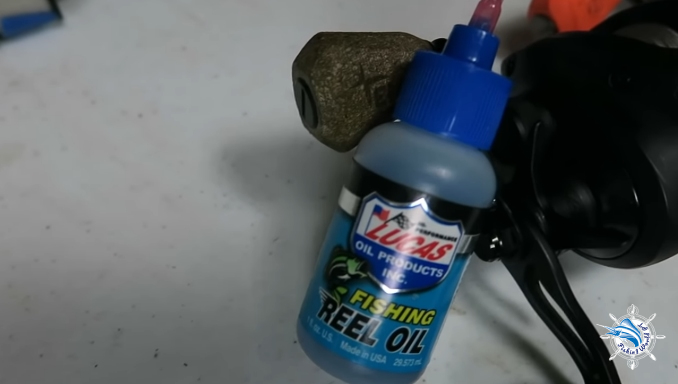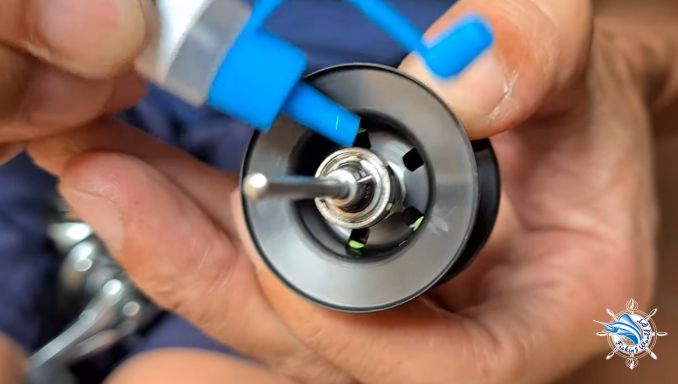How To Clean A Baitcasting Reel?
Many anglers use fishing gear but rarely pay attention to how to maintain it, especially how clean the reel. While cleaning the reel is a necessity after fishing trips for the reel to work longest. And make sure that there are no problems during fishing.
In this article, I will show you how to clean a baitcasting reel. Assembling a baitcaster is probably a bit more difficult than a spinning. But I will try to make it as simple as possible.
I once wrote an article about cleaning a spinning, you can check it out here: How To Clean Fishing Reel Bearings?
This article will show you how to remove, clean, and oil a baitcasting. Let’s get started!
What can I use to clean my fishing reel?
Firstly how do you clean your fishing reels? The first thing I would do is if you’ve got sand or dirt or grime on it, the first thing I would do is run some water over it and wash it.
I don’t think you want to do it to clean it with any cleaners any claws as Clorox wipes. You don’t want to use any chemicals when cleaning a baitcaster, and here’s why?
For fish, there are 3 reasons: sight, sound, and scent. Suppose you get any chemicals or anything on here, especially on the line. Fish will smell that, and you could throw the bite out the window if you get any of that scent on your fishing line before you head back out. Do not use any cleaners when cleaning your reel.
What you want to do if you’ve got mud or sand or dirt in on your fishing rail on your line or wherever you want to do is wash it with lukewarm or cold water and not close up, say if you’re spraying it with the hose or if you’re inside with a faucet you want to run water over it.
Just run some water over it. You know, for good 30 seconds, 2 minutes, get all the grime and dirt off it and then set it aside and let it dry.

How to clean a baitcasting reel
What you need now is a soft cloth or paper towel, cotton swabs, and a bottle of fishing reel maintenance oil. Now follow the steps below clean your reels.
- First, use a damp cloth to wipe off dust and dirt from the outer body of the reel.
- Use a cotton swab to clean small details like the level wind, line spool, and spool tension adjustment. With the spool tension adjustment, open it up to clean all the water inside.
- Open the brake clean the inside. Next, remove the line spool. Remember to use tape to fix the lines to prevent them from coming out.
- Clean all internal components after removing the components. You must remember to wipe off all the water to avoid causing rust to the reel.
- Next, when you have cleaned all the water and dirt at all joints where you think there will be rotation, such as bearings, spools, handles…In each place like that, put a drop of oil in it. Gently rotate them so that the oil flows evenly.

That’s it. You’ve got a clean and smooth reel. It is advisable to do so after each fishing trip to keep your reel operating at its best and avoid damage.
A serious tournament angler should oil the reels every few months and oil the gears once or twice a year, especially if they fish a lot around the lawn. The reels used in saltwater need more frequent attention.
Normally, for freshwater fishing, depending on the tightness of the reels, you should clean it 1-3 months after use. For non-salt-resistant saltwater, each fishing trip should be washed and dried before storing and curing after 3-5 uses. For some low-profile salt-resistant reels, clean after using about 5-7 times. Depends on the salt resistance of the reel.

Some extra tips for cleaning your fishing reels
In addition to the essential steps in How To Clean A Baitcasting Reel, here are some expert tips that can help keep them in top condition. Regular maintenance will ensure smooth performance and a longer life for your favorite tools on every angling adventure!
To ensure that your reel works optimally, refrain from pairing metal with metal as this could result in damage. Instead pair metals with fiber parts for ideal results and performance.
Tweezers are essential when dealing with small components like wire clips and springs, to keep them securely in place and prevent their accidental misplacement.
To avoid unwanted displacement of your reel’s spool, make sure to secure the fishing line before removal.
Proper lubrication is key to keeping your reel running smoothly; one drop of oil on each bearing is enough to ensure longevity for your fishing reels. For a quick clean, lighter fluid can be used on ball bearings to remove debris buildup quickly and efficiently.
To ensure the reel reassembles accurately and in its proper order, be sure to handle it carefully during both disassembly and assembly.
To ensure optimal performance, avoid oiling the anti-reverse bearing to prevent any damage or instability.
For optimal performance and longevity, ensure to loosen your fishing reel’s drag after each outing. This allows the grease inside the washer to return to its intended position.
Ensure your reels are in perfect order by strategically placing masking tape on the parts and labeling them accordingly. A soft mat is ideal for safely laying all components out, helping to maintain their quality during assembly and reconstruction.
More Tips On Maintaining Your Baitcasting Reel
Learning how to maintain a baitcaster is just as important as how to clean a baitcaster. Here are some tips you need to remember:
1. Rinse and Dry After Every Use: This is one of the most important steps in maintaining a baitcasting reel. Always rinse your reel with fresh water after fishing, or when it becomes exposed to saltwater. Allow the reel to dry completely before storing.
2. Lubricate Regularly: A well-lubricated reel will help keep everything running smoothly and will help extend its life. Most manufacturers suggest lubricating your reel at least once every two months for maximum protection from wear and tear. Look for special oils designed specifically for fishing reels, as these will provide better lubrication than general-purpose oils or WD-40, which can damage the internal components of some baitcasting reels.
3. Use Reel Covers: Even if you rinse and dry your reel after every use, it’s still a good idea to store it in a protective cover when not in use. A reel cover will help protect the interior components from dirt and dust that can cause damage over time.
4. Check for Wear: Regularly inspect your reel for signs of wear or damage. Pay particular attention to the condition of the spool, which is more likely to suffer from wear due to friction with the line. Make sure any screws are tight and check for any loose parts or other signs of deterioration.
5. Replace Line as Needed: Old lines can be abrasive on your reel and cause premature wear and tear. Replace it with a fresh line at least once a year, or more often if you notice it has become brittle or frayed.
6. Keep your reel safe and sound by ensuring it remains cool and dry when not in action.
7. Keep your reel safe from physical shock: When not in use, keep it stored away in a hard, shock-resistant container. Avoid dropping or banging it, which could cause harm to its internal components.
8. Store your reel properly: Never store your reel with a fishing line still attached or without the spool inside its body.
9. Make sure it receives professional service: Attempting a DIY fix may leave you without coverage should an issue arise in the future – so save yourself hassle and costs by having a technician handle repairs!
10. Make sure to read through the manufacturer’s instructions before trying out your reel. Following these guidelines carefully can help you get optimal performance from your equipment and keep it in great condition for longer!
By following these tips, you can help keep your baitcasting reel in tip-top shape and get years of use out of it. Even if you’re an experienced angler with plenty of experience using this type of equipment, regular maintenance is still essential for keeping your gear performing at its best. With just a little bit of time and effort spent on cleaning and maintaining your baitcasting reel, you can help ensure that it will last for many seasons to come!
Can I use WD-40 for clean a baitcasting?
You can use the WD-40 on your fishing reels for annual maintenance. The WD-40 will not damage your reel and it can be used in place of cleaners, degreasers or to remove non-stuck components. However, WD-40 should not be used for routine maintenance.
Since WD-40 is a degreaser, it breaks down grease. Never use it to lubricate a rotating shaft. WD-40 won’t damage your fishing reel, and it can be used in place of cleaners, degreasers, or to remove unstuck parts…
FAQs
How often should you clean a baitcaster?
For optimal performance, maintaining your baitcaster is a must. The frequency of cleaning depends on usage and the saltwater-resistance levels of the reel. To ensure your baitcaster remains in its best condition, a monthly cleaning is recommended. If you’re planning to fish in saltwater conditions or have already been doing so, regular maintenance of the reel should be considered essential for successful outings and long-term performance.
Can you oil a baitcaster with WD-40?
No, WD-40 is not suitable for use with baitcasting reels. This petroleum product can weaken the essential lubricants in the reel resulting in faster wear and tear – even causing it to seize up, leading to unreliable performance and even failure. Instead, look for special oils designed specifically for fishing reels to lubricate your reel. This will provide better lubrication and protection from wear and tear.
Is WD-40 good for fishing reels?
Yes, WD-40 can be an ideal choice for maintaining your external fishing reels components, like cogs and gears. However, keep in mind that its use on internal parts of the reel could cause significant harm to performance and longevity.
Do I need a reel cover?
Yes! Even after rinsing and drying the reel after each use, a protective cover can help keep dirt and dust away which can cause damage over time. It’s also important to store your reel properly without a line attached or without the spool inside its body. Reel covers are a great way to protect your investments in larger rods and reels while they are being stored away during off seasons or periods of non-use.
Can a dirty baitcaster cause problems?
Yes, dirt and grime can get stuck in the inner workings of your reel, causing it to malfunction or jam during use. Regular cleaning and maintenance will help prevent these issues from occurring and keep your reel performing efficiently year after year. Additionally, storing your reel in a protective cover when not in use can also help protect its interior components from dust and dirt buildup which could otherwise cause problems.
Grime buildup can cause excess friction which can, in turn, cause your reel to run slower or even seize up during use. Additionally, dirt particles can also be abrasive and wear down the delicate internal components of your reel – so cleaning it regularly is key to avoiding these issues!
Now you know how to clean baitcasters so never let the above affect you.
Conclusion
You already have the answer to the “How to clean a baitcasting reel?”. Remember, no reel can be used forever. They can only function well for a while if properly maintained and oiled regularly.
I hope this article is helpful to you. Do you have another idea?
Hope you got your questions answered. Good luck!
Further reading:
- Other info about fishing in Fishingandhuntingsports
- Fishing reel Wikipedia
- What can I use to clean my fishing reel?

